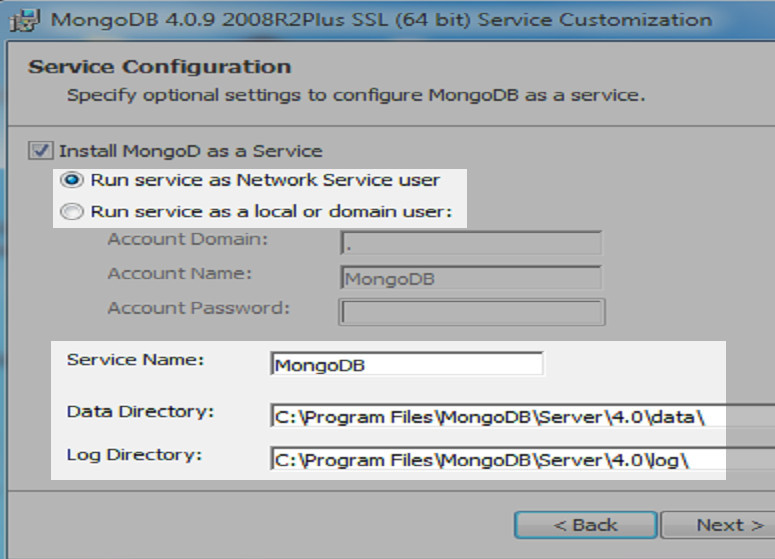

Probes: Probes ensure that the container does not get stuck in a loop due to any bug and can be restarted automatically in case an unexpected error comes up.
#Install mongodb as a service password
to assign a password to the MongoDB database, the required password must be supplied securely to the MongoDB container. Sometimes the containers need to know the sensitive data to use it.Į.g. Let us dive deeper and understand what each part is doing.

The Deployment YAML of MongoDB has a lot of components such as env vars from secrets, probes, etc. apiVersion: apps/v1Ĭreate the deployment. Here we use the official mongo image from docker hub. Save the following manifest as mongodb-deployment.yaml. I have added an explanation for the MongoDB deployment file as well towards the end of this section. This is because only one pod will be spun up. Here, in this example we are deploying a standalone MongoDB instance, therefore – we can use a deployment object. Case of statefulsets: name of pod initially: mongo-0 name of pod after it gets deleted & recreated: mongo-0 Here, pod name remained the same. Let's take an example of mongodb to understand the difference better.Ĭase of deployments: name of pod initially: mongo-bcr25qd41c-skxpe name of pod after it gets deleted & recreated: mongo-j545c6dfk4-56fcs Here, pod name got changed. In the case of the stateful set – each pod is assigned a unique name and this unique name stays with it even if the pod is deleted & recreated.

In the case of deployments, pods are always assigned a unique name but this unique name changes after the pod are deleted & recreated. Let’s try to understand this briefly.Ī deployment is a Kubernetes object which is preferred when deploying a stateless application or when multiple replicas of pods can use the same volume.Ī stateful set is a Kubernetes object which is preferred when we require each pod to have its own independent state and use its own individual volume.Īnother major difference between them is the naming convention for pods. People beginning their journey into containers and Kubernetes, often get confused about the use cases of Kubernetes Deployment and Statefulset. Path: /data/mongo Deployments vs StatefulSets Note: If you dont have the option to provisiong, dynamic volumes using PVC, you can use the normal persistant volumes with the following manifest and map it to the deployment apiVersion: v1 Save the following manifest as mongodb-pvc.yaml. Let’s create one PVC for our MongoDB instance. PVC works only if you have dynamic volume provisioning enabled in the Kubernetes cluster. Kubernetes looks for a PV from which space can be claimed and assigned for a PVC.

PersistentVolumes (PV): are objects which map to a storage location.In Kubernetes, there are two objects which are required for creating volumes. In this way, even if our pod goes down – the data is not lost. We require volumes to store the persistent data. after decoding it, this will give devopscube Create MongoDB Persistent Volume Run echo "ZGV2b3BzY3ViZQo=" | base64 -decode after encoding it, this becomes ZGV2b3BzY3ViZQo= If you want to see how your string will appear in a base64 format, execute the following. Kubernetes stores the content of all secrets in a base 64 encoded format. Save the following manifest as mongodb-secrets.yaml apiVersion: v1Ĭreate the Secret. We will use Secrets to mount our desired passwords to the containers. They are like ConfigMaps with the difference that data is stored in an encoded format.įor the security of our MongoDB instance, it is wise to restrict access to the database with a password. Secrets in Kubernetes are the objects used for supplying sensitive information to containers. Īfter you deploy MongoDB on kubernetes, to clean up the deployment objects, execute the following. If you don’t want to go through creating each manifest, just clone the repo and execute the following command from the cloned directory. We have explained all the MongoDB Kubernetes YAML files. Clone the repository for reference and implementation. MongoDB Cluster Kubernetes ManifestsĪll the Kubernetes Mngdb YAML manifests used in this guide are hosted on Github. Going step by step ensures that you can focus on understanding the ‘why’ while learning the ‘how’. As a beginner, creating components one by one while understanding the steps involved is a great way to learn about Kubernetes and MongoDB.
#Install mongodb as a service how to
Towards the end, we will discuss how to do basic operations inside MongoDB. We will also discuss how to make the cluster accessible from outside Kubernetes. This article aims to explain each of the components required to deploy MongoDB on Kubernetes.


 0 kommentar(er)
0 kommentar(er)
